The Menhirs of Carnac
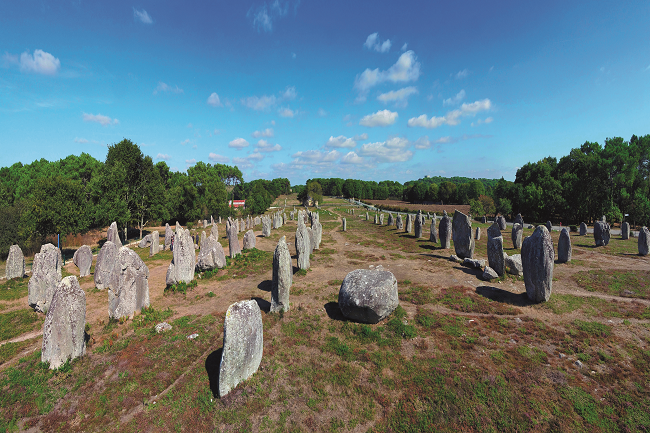
Step back in time as we head to Morbihan, in Brittany, to explore the iconic standing stones at Carnac.
Saint Cornelius wasn’t too fond of pagans. Back in the third century BC, finding himself pursued by an army of Roman legionaries, he used his religious powers to transform them all into stone. The result of his curse survives to this day in the form of 3,000 megalithic stones, standing sentry in row upon row and spread out across southern Morbihan, near the coast of Brittany. That’s if you believe the legend.
They’re called the Carnac alignments. Stretching for 4km or so northeast from Carnac, the large, grey granite boulders are upright, evenly spaced, vaguely symmetrical and embedded into the soil. There are other formations, too: cairns, stone tombs called dolmens, burial mounds called tumuli, and enclosures, where the stones have been placed close together, often in a half circle or horseshoe shape. Altogether, they constitute the largest group of standing stones on the planet.
The individual boulders – or menhirs, as they are known- range in height: some are just a metre high, others much taller than your average human. The most impressive of all, called Le Géant du Manio, which stands guard a short way west of Kerlescan, is around six metres high. Even Asterix’s sidekick Obelix, who was rather fond of a menhir, would have had a tricky time carrying this one.
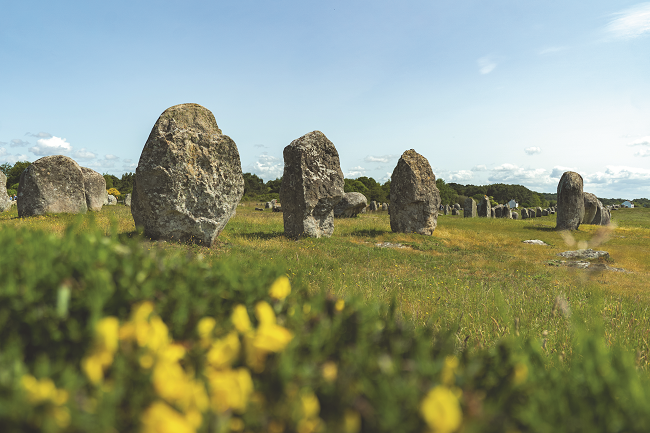
©Poriel Thibault
An impressive sight
Taken singly, the stones aren’t particularly impressive; certainly not on the scale of Stonehenge, for example (which they pre-date by at least 1,000 years, by the way). But when you view them as a group, from up high, the effect is awe-inspiring, especially when you consider the physical effort involved in their placement. It was on a cool morning this past spring from the terrace of the Maison des Mégalithes (the visitor centre for the entire site) that I got my first aerial view of Carnac’s stones.
From here you can look across Le Ménec alignment and immediately you understand why ancient Gauls might have thought this was a Roman army turned to stone.
That afternoon, I followed the long footpath that runs alongside and mostly parallel to the groups of stones. There are five separate alignments in all, starting just north of Carnac with Le Ménec, which lies close to the hamlet of the same name. Then come the Kermario, Le Manio and Kerlescan alignments, finishing with the smallest group of all, Le Petit Ménec alignments.
During the winter months, you’re allowed to mingle freely among the stones, but in summer, as tourists descend in their droves on this part of Brittany, you’re obliged to join an official guided tour. Metal green fences encircle each alignment, and some of the local residents are distinctly unhappy about the restricted access – at several points along the line of the fence, they’ve placed signs complaining about the situation.
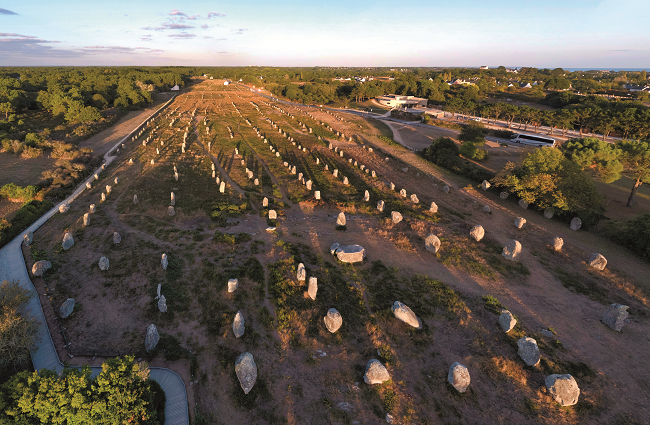
Nearly 3,000 standing stones make up the Carnac alignments, an impressive sight, especially when seen from above © CHRISTIAN GLUCKMAN
There is one group of locals, however, permitted access all year round: the flocks of sheep which wander and graze between the stones. As a form of grass management, it’s a nifty solution, especially since even the most intrepid gardener would have a job getting an industrial mower in between the thousands of stones.
Perusing these prehistoric monuments, the first question any modern-day visitor asks is, ‘how on Earth did they get there?”. Over the centuries, archaeologists have pored over the menhirs, studying them in detail. The consensus now is that they were erected between 4,500 BC and 3,500 BC, during the Neolithic period, by early farming communities living in the region, using granite from the local bedrock beneath the soil.
The Centre des Monuments Nationaux, France’s government body in charge of the country’s historic sites, published a new book this year called The Carnac Alignments: A Landscape of Prehistoric Megaliths.
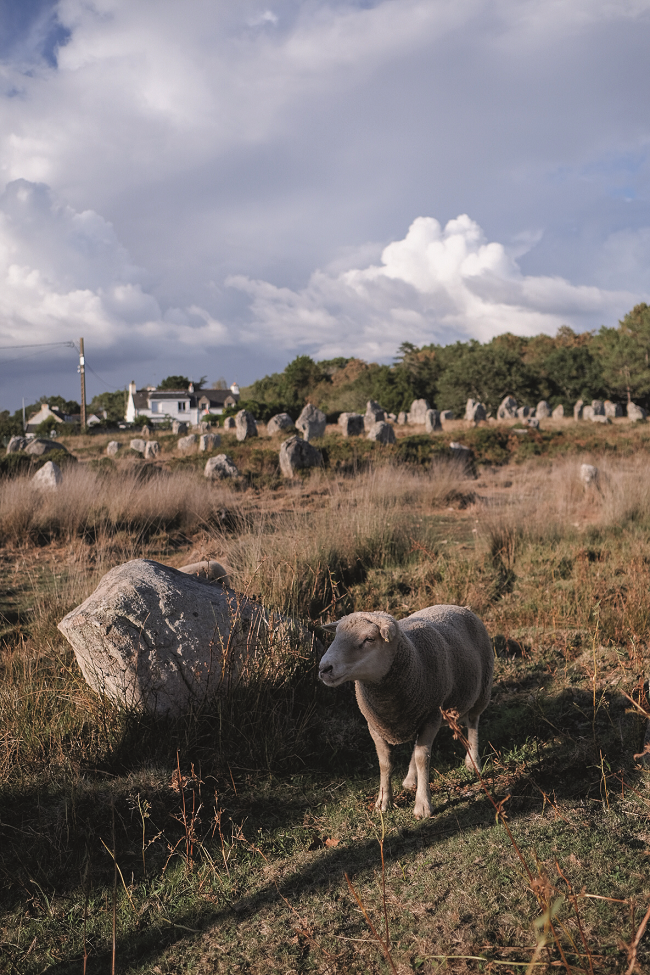
Sheep graze peacefully among the many menhirs © MORGANE SCHALLER
“Were they erected over a period of several months or years by a large number of people taking part in a highly organised building project, or did the construction take dozens, even hundreds of years, with a much smaller group raising the stones only on special occasions?” the authors ask. “Are the alignments the result of a massive collective effort or of gradual individual acts? Possibly both.”
The second, more pressing, question is, ‘why on Earth were they put there?’. Much ink has been spilled in attempts to answer this. Perhaps they were religious monuments, related to the worship of the sun or the moon. Or a message for future generations? Or, since this was a period in history when humans had recently switched from hunter-gatherer to agrarian societies, were they linked somehow to the farming calendar? Did they perhaps act as a sort of territorial boundary between different tribes? One theory is that, long ago, this region was far more susceptible to seismic activity and the stones were an early-warning system for earthquakes, since even small tremors in the ground would dislodge them slightly from their positions.

© CHRISTIAN GLUCKMAN
Searching for meaning
One of the best-informed experts on the phenomenon is Serge Cassen, a researcher at the University of Nantes. He suggests we should observe the spaces between the standing stones just as closely as we observe the stones themselves. “When you cross between the stones it’s like you’re crossing a frontier,” he once explained.
Interestingly, back when the stones were erected, 6,000 or so years ago, the land in this part of Morbihan was very flat with few trees. It wasn’t long after the last ice age, either, so melting glaciers meant sea levels were rising, making the gulfs along Brittany’s coast – including the Bay of Quiberon that Carnac sits in – extremely vulnerable to flooding.
The truth is, no one can really be sure why the stones were erected and perhaps we will never know. According to the Centre des Monuments Nationaux, the jury is very much still out. “The standing stones of Carnac have not yet revealed the reason for their existence,” they say. “Seemingly with no links to the stars, sun or moon… The spectacle of the megaliths gives an idea of the incredible story that was written here over several thousands of years, by the will of men and women seeking to convey some kind of message.”

© MARTA GOIKOETXEA
It’s a statement I must confess to finding a little underwhelming. Surely after all this time, some bright archaeologist would have finally cracked the enigma?
One summer, while on holiday near Carnac with my family, I was pondering this very question. I was on the Plage de Saint-Colomban, just west of Carnac, building a sandcastle with my two kids. As the tide began to come in, they worked furiously to protect their castle from the ocean, using more and more sand to rebuild the walls each time an incoming wave overran it. Ultimately, though, they knew full well it was a fruitless task.
So if I may advance a theory of my own… Perhaps the Carnac stones are similar to my kids’ sandcastle, and in an era when sea levels were rising, those industrious locals erected these impressive Neoliths as a symbolic but flawed defence against the incoming tide.
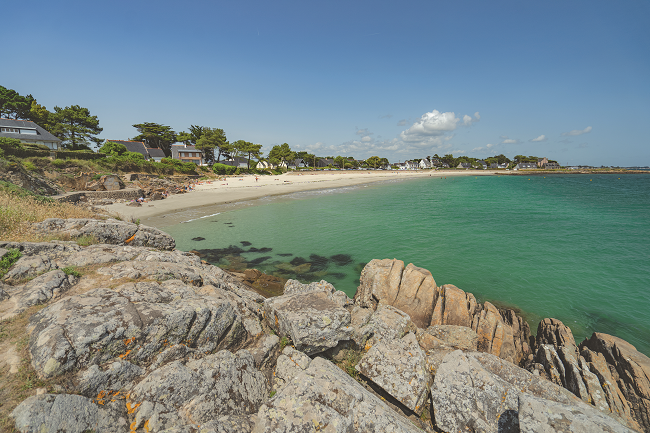
Relax on the town’s beautiful beaches ©Poriel Thibault
Visiting the Carnac alignment
A good place to start is the Maison des Mégalithes, the visitor centre at the western end of the alignments, just a kilometre north of Camac-Ville town centre. Open all year round and free to visit, it has exhibits and films explaining the significance of the whole site. Standing on the terrace, you’ll get a fantastic aerial view of Le Ménec alignment.
From here it’s best to explore the stones on foot. From October to March you can wander freely between them but, from April to September access is only permitted with a tour guide. You can, however, view the stones from beyond the surrounding fences. Less mobile visitors can drive along the D196, which runs parallel to the alignments, stopping to view stones along the way.
Another site worth visiting is the Musée de Préhistoire which traces human history across Brittany from the Paleolithic era to the Middle Ages.
More information here: www.carnactourism.co.uk
Exploring Carnac
Split into two distinct districts – Carnac-Ville and Carnac-Plage – this pretty seaside town is the perfect summer holiday spot. Like many of the more upmarket Brittany beach resorts, it has a preppy feel to it (or BCBG – bon chic, bon genre – as the French say).
Carnac-Ville boasts some interesting (and very touristy) shops and restaurants in the streets around the Renaissance-style Église Saint-Comély. Much more exciting, though, is the grid of streets set back from the main beach at Camac-Plage. Here, on warm summer days, you can wander down the bar and restaurant-lined Avenue Miln, Avenue des Druides and Allée du Parc, mingling with well-heeled French holiday-makers and second-homers dressed in sailing brands and cashmere jumpers. Whatever you do, don’t miss the ice cream parlour l’Igloo, on the corner of Avenue Miln and Allée du Parc. Founded back in the 1970s, it serves all the classic flavours you’d expect, as well as some rather palate-challenging ones. Sweet potato and cinnamon? Flambéed banana in curry? Pomegranate and hibiscus flower? Come on, be bold. You’re on holiday.
Carnac has five beaches to choose from in all, letting you follow the sun from moming to dusk for the rising sun, try the Plage de Beaumer: facing south is the main stretch of sand, la Grande Plage, overlooked by some enormous and beautiful villas lining the Boulevard de la Plage; also south-facing are the smaller Plage de Légenèse and Plage de Ty Bihan; by sunset you’ll have moved to the west-facing Plage de Saint-Colomban. All five boast fine sand and sheltered waters, making them perfect for bathing and water sports.

Make time to visit the fashionable resort of Carnac-Ville © MARTA GOIKOETXEA
Getting there
By ferry – Dominic Bliss travelled to France on Brittany Ferries which sails daily direct to Brittany on two routes: Portsmouth to Saint-Malo and Plymouth to Roscoff. Prices start from £125 each way for a car and two people. Visit www.brittany-ferries.co.uk
From France Today Magazine
Lead photo credit : © CHRISTIAN GLUCKMAN
Share to: Facebook Twitter LinkedIn Email
Leave a reply
Your email address will not be published. Required fields are marked *




REPLY